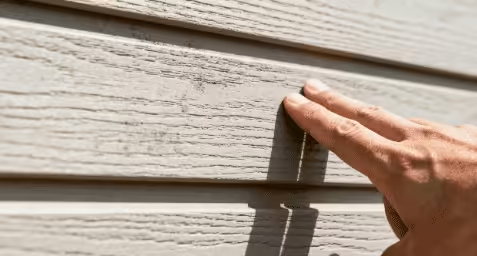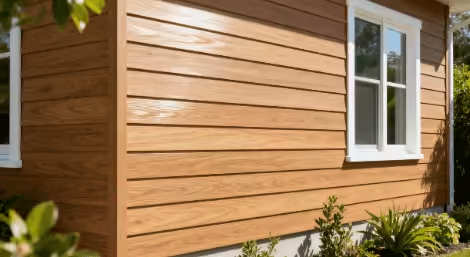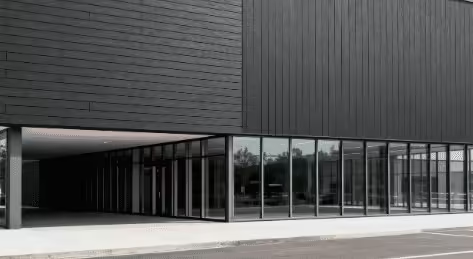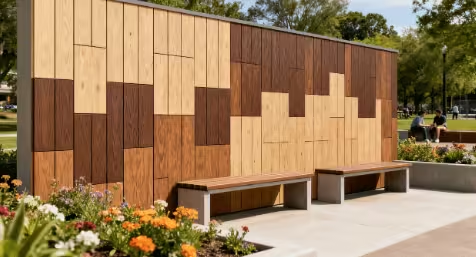Table of Contents
Introduction

In an era where health and sustainability are paramount, the choice of building materials plays a crucial role in creating living spaces that are not only aesthetically pleasing but also safe and environmentally responsible. As modern architecture and interior design increasingly demand high-performance solutions, innovations in decorative materials have become essential. Among these, Wood-Plastic Composite (WPC) outdoor wall panels stand out as a revolutionary option, particularly for their remarkable durability, aesthetic versatility, and, most importantly, their advanced anti-bacterial properties. These panels are expertly crafted to offer the rich, natural look of real wood without the typical high maintenance.
This blog post will delve into the world of WPC outdoor wall panels, exploring their composition, core advantages, and how they serve as an ultimate guardian for healthy homes by providing superior protection against dampness, noise, and bacterial growth. We will uncover the technological breakthroughs that make these panels a cutting-edge solution for various applications, from residential facades to commercial exteriors.
What are WPC Outdoor Wall Panels?

WPC (Wood-Plastic Composite) is a novel environmentally friendly building material that combines natural wood fibers (such as wood powder, bamboo powder, and straw) with thermoplastic plastics (such as PE or PVC). Through a high-temperature and high-pressure extrusion process, the wood-plastic components form a dense structure that possesses both the natural texture of wood and the weather resistance of plastic. This innovative material effectively addresses the shortcomings of traditional wood, which is prone to rot, and plastics, which are difficult to degrade.
The technical breakthroughs in WPC material are significant. More than 60% of its composition comes from agricultural and forestry residues, such as straw and wood chips, thereby reducing reliance on natural timber. The manufacturing process is zero-pollution, with no formaldehyde or benzene series compounds added, ensuring compliance with national E0-level environmental standards and EU REACH regulations. Furthermore, WPC outdoor wall panels exhibit ultra-high strength, achieved through high-density extrusion technology, with a substrate density reaching 0.9g/cm³ and a flexural strength 30% higher than ordinary wood.
Shandong Panel International Trade Co., Ltd. is committed to innovation-driven and quality-first principles, offering high-quality, cost-effective decorative materials, including WPC boards. Our outdoor WPC siding, also referred to as outdoor WPC wall panels, is specifically designed to provide unmatched durability and aesthetics for exterior applications. They are a sustainable solution for projects worldwide, made from renewable materials that meet green construction standards.
The Rise of Anti-bacterial WPC Outdoor Wall Panels for Healthy Living
One of the most compelling advantages of modern WPC outdoor wall panels is their advanced anti-bacterial performance, which positions them as a vital component for healthy living environments. Traditional outdoor building materials can be susceptible to mold and mildew growth, especially in damp conditions, which can lead to health issues and structural degradation. WPC outdoor wall panels, however, offer a solution to these concerns.
These panels incorporate a nano-level antibacterial layer, demonstrating an inhibition rate of over 99% against common bacteria like E. coli and various molds. This feature is particularly crucial for outdoor applications where exposure to environmental elements can foster microbial growth. By significantly reducing the presence of harmful microorganisms, WPC outdoor wall panels contribute to a cleaner and safer surrounding area, making them an ideal choice for residential settings, public spaces, and even commercial exteriors where health and hygiene are priorities.
Furthermore, the commitment to safety extends beyond just antibacterial properties. WPC outdoor wall panels boast near-zero VOC (Volatile Organic Compound) emissions during their use, making them safe for sensitive environments such as homes with infants and children, and even hospitals, allowing for immediate occupancy after installation. This combination of effective antibacterial protection and minimal harmful emissions truly positions WPC outdoor wall panels as an ultimate guardian for healthy homes and public spaces, ensuring peace of mind for occupants and users.
Key Features and Advantages of WPC Outdoor Wall Panels

WPC outdoor wall panels are distinguished by a comprehensive set of features and advantages that set them apart from traditional building materials:
Exceptional Environmental Performance
WPC materials prioritize sustainability. They utilize renewable resources like straw and other agricultural residues as raw materials, reducing the demand for natural timber and preventing deforestation. The production process is clean, employing low-temperature hot pressing technology for efficient energy use with no wastewater or exhaust gas emissions. Their safe usage is further guaranteed by VOC emissions that are close to zero, making them suitable for installation in sensitive environments such as homes with children and hospitals. These products are suitable for green buildings and sustainable development projects, aligning with international environmental standards.
Superior Physical Properties
The durability of WPC outdoor wall panels is unparalleled. They exhibit excellent waterproof and moisture-proof capabilities, with a water absorption rate of less than 0.5% and no deformation even after being submerged for 72 hours, effectively preventing wall mold issues. They are also fire-retardant, meeting GB8624-2012 A-level certification, meaning they do not spread flames and release no toxic smoke when exposed to an open fire. Furthermore, WPC outdoor wall panels are highly durable, resistant to UV rays, and can withstand extreme temperature differences from -30℃ to 70℃, ensuring an outdoor lifespan of up to 25 years. Their high elasticity and strong impact resistance also contribute to their robustness.
Revolutionary Installation Experience
The installation process for WPC outdoor wall panels is designed for efficiency and ease. Their lightweight design, with a thickness of only 6-10mm and a single panel weight of 5kg/㎡, makes them 90% lighter than ceramic tiles, significantly reducing construction load. The modular interlocking installation system eliminates the need for professional tools, allowing a single person to cover an average of 50㎡ per day. Additionally, they can be directly installed over existing walls, bypassing the need for base material removal, which saves 50% of construction time and reduces construction waste by 90%. WPC outdoor wall panels can be easily cut with a utility knife and fixed to the wall using hardware fasteners, allowing for immediate use after installation.
Deep Integration of Aesthetics and Functionality
WPC outdoor wall panels offer extensive design freedom, supporting 3D printing and customization with over 200 patterns, including realistic wood grain, stone patterns, and metallic textures. Beyond aesthetics, they provide practical benefits such as sound insulation, with 15mm thick panels achieving up to 28 decibels of sound reduction, and a hollow structure that improves thermal insulation efficiency by 20%. This makes them an excellent choice for environments requiring quiet, such as hospitals, schools, libraries, and home theaters.
Significant Economic Advantages
From an economic perspective, WPC outdoor wall panels offer substantial savings. They can reduce material costs by 50% compared to solid wood wall panels, and eliminate additional expenses for painting, anti-corrosion treatments, and other maintenance. Maintenance is incredibly convenient, typically requiring only a simple wipe with clean water, with no risk of cracking or deformation, ensuring long-term peace of mind and cost-effectiveness. Furthermore, these materials are highly resistant to acid and alkali corrosion, making them suitable for harsh environments like hospitals and laboratories. Their good thermal conductivity and uniform heat dissipation, coupled with a small thermal expansion coefficient, contribute to their stability and suitability for various climates.
Table: Key Advantages of WPC Outdoor Wall Panels
| Feature Category | Specific Advantage |
| Environmental | Renewable materials, near-zero VOC emissions, 99% antibacterial |
| Durability | Waterproof (<0.5% absorption), fire-retardant (A-level), 25-year lifespan, UV resistant |
| Ease of Installation | Lightweight (5kg/㎡), modular interlocking, direct old wall covering |
| Aesthetics | 200+ customizable patterns (wood, stone, metallic), 3D textures |
| Functional Benefits | 28dB sound insulation, 20% improved thermal insulation efficiency |
| Cost-Effectiveness | 50% material savings vs. solid wood, low maintenance, long-term value |
Addressing Common Concerns: Durability and Maintenance of Outdoor Wall Panels
While WPC outdoor wall panels offer numerous benefits, it is important to address potential concerns, particularly regarding long-term durability and maintenance. Some WPC products, especially those with longer dimensions used in outdoor settings, may experience gradual bending or sagging over time. This deformation is a common defect observed after two to three years of use.
The primary causes of such deformation include temperature stress and creep. In warmer temperatures, WPC materials undergo thermal expansion. For longer panels, significant expansion can lead to high temperature stress if the ends are fixed. If this expansion exceeds a certain limit, the panel can buckle and bend. Conversely, in colder temperatures, WPC’s toughness and strength decrease, and contraction can generate stress at fixed points, potentially leading to damage. Another factor is moisture absorption creep. During rainy seasons, WPC absorbs water and expands, leading to slight, irreversible creep elongation. This effect can accumulate over repeated wet-dry cycles. The combined result of temperature stress creep and moisture absorption creep can cause initially straight panels to visibly curve over several years.
To mitigate these issues, specific design and manufacturing considerations are crucial. Effectively treating plant fibers in the WPC composition is vital to significantly reduce their hygroscopicity, as plant fibers are highly moisture-absorbent compared to the polymer matrix. Manufacturers must prioritize lowering the water absorption rate of WPC materials during formulation and process design, with strict water absorption rate tests serving as a key quality indicator. Controlling and reducing the linear expansion coefficient of WPC materials can effectively manage temperature stress.
Furthermore, improving the anti-aging performance of the surface layer is critical for long-term color durability and resistance to chalking and fading. This is because aging primarily develops from the exterior inwards. Using high-quality inorganic pigments with enhanced resistance to acid rain, which can corrode pigments, also plays a significant role. Some advanced solutions involve producing WPC profiles with a PVC/PVC double-layer structure using co-extrusion. In this design, the PVC-based surface layer focuses on aesthetics and extended lifespan, while the PVC-based core layer addresses dimensional stability, physical-mechanical properties, and cost optimization.
Research indicates that PVC offers superior creep resistance, making it more suitable as the resin base for outdoor WPC materials. Manufacturers should also ensure that their internal quality standards for outdoor WPC products, including water absorption rate, water absorption expansion rate, dimensional change rate, and linear expansion coefficient, exceed national and industry standards by over 25% to better meet outdoor application requirements.
Despite these potential challenges, modern WPC outdoor wall panels are engineered for low maintenance. They are easy to clean and waterproof, typically requiring only a wipe with clear water for daily upkeep, which saves considerable time and effort compared to traditional wood options. This emphasis on both preventative design and simple maintenance ensures that WPC outdoor wall panels remain a durable and practical choice for exterior applications.
Applications of WPC Outdoor Wall Panels

The versatility and robust characteristics of WPC outdoor wall panels make them suitable for an extensive range of applications, both commercial and residential. Their ability to combine durability with aesthetic appeal allows them to seamlessly integrate into various architectural styles and environmental demands.
Commercial Exteriors
WPC outdoor wall panels are an excellent choice for a variety of commercial settings. They are ideal for enhancing the facades of shops, cafes, hotels, and entertainment venues, providing a sophisticated and low-maintenance exterior that can withstand heavy public use and diverse weather conditions. Their ability to replicate natural wood aesthetics with superior performance makes them a preferred material for creating inviting and durable commercial spaces. They have been widely used in public buildings and commercial spaces in many countries and regions.
Residential Settings
For homeowners, WPC outdoor wall panels offer a practical and beautiful solution for various exterior applications. They are perfect for garden fences, balconies, patio walls, and house facades, bringing depth and elegance to outdoor living areas. Their resistance to moisture, insects, and harsh weather conditions makes them a smart, long-term investment for any outdoor environment, providing the timeless look of wood without the demanding upkeep. They can transform home outdoor living areas, including living rooms, bedrooms, kitchens, balconies, and studies.
Public and Decorative Use
Beyond commercial and residential projects, these panels find application in public spaces and decorative installations. They are suitable for parks, community spaces, and various outdoor decorative uses, contributing to sustainable and attractive public infrastructure.
Specialized Environments
WPC outdoor wall panels are also well-suited for more specialized applications where performance requirements are high. This includes educational systems (schools, training centers, kindergartens), medical systems (hospitals, laboratories, pharmaceutical factories), and transportation systems (airports, train stations, bus stations, docks). Their durability, ease of maintenance, and health-conscious properties, such as being antibacterial and having low VOC emissions, make them a superior choice for these demanding environments.
Renovation Projects
For the renovation of existing buildings, particularly second-hand homes, WPC outdoor wall panels offer significant advantages. Their modular installation system allows for quick construction, produces minimal waste, and eliminates the need for residents to relocate during the renovation process. Crucially, their formaldehyde-free composition means that spaces can be occupied immediately after installation, offering a convenient and healthy solution for modernizing older properties. This makes WPC outdoor wall panels a versatile and adaptable solution for virtually any outdoor wall application.
WPC Outdoor Wall Panels in a Sustainable Built World
The commitment to sustainability is at the core of WPC outdoor wall panels. They are a pioneering decorative material designed for a sustainable built world. Shandong Panel International Trade Co., Ltd. is dedicated to offering high-quality, cost-effective decorative materials made from renewable sources, ensuring they meet green construction standards and provide sustainable solutions for projects globally.
WPC materials contribute significantly to a circular economy model by promoting “reduction, reuse, and resourcefulness”. The primary raw materials for WPC, such as natural stone powder (calcium carbonate) and wood/plastic bases, along with common additives, are environmentally safe and non-toxic. The production process itself is designed to be eco-friendly, without generating harmful byproducts to people or the environment. Furthermore, WPC outdoor wall panels are 100% recyclable, meaning that end-of-life products and recycled waste can be fully reused without compromising performance. This remarkable recyclability is crucial for protecting natural resources and ecological environments in an era focused on sustainable development.
The widespread adoption of WPC products, driven by national policies encouraging a circular economy and the pursuit of corporate benefits, has led to a “wall panel fever” across industries. The rapid development of WPC composite materials aligns perfectly with China’s policy of building a resource-saving and environment-friendly society and promoting sustainable development. Especially with the increasing concerns about greenhouse gas emissions and the push for a “low-carbon economy,” the value of WPC composite materials has become even more apparent.
Looking ahead, the development trend for WPC outdoor wall panels is towards functional integration and higher added value. Researchers and users are demanding more from these materials, including enhanced anti-aging and anti-fading properties for outdoor landscaping products, improved flame retardancy for indoor doors, windows, and decorative components, and higher mechanical performance for structural components. There is also a growing demand for improved energy efficiency in construction, leading to the development of WPC products with better thermal insulation.
Therefore, the future of WPC outdoor wall panels lies in specialized functionalities such as enhanced flame retardancy, reinforcement, anti-aging, anti-creep, and superior thermal insulation. Innovations like nano flame retardant technology can raise fire ratings to A1, and ecological upgrades with plant-based adhesives further reduce the environmental footprint.
Conclusion
WPC outdoor wall panels represent a significant advancement in decorative building materials, offering a harmonious blend of aesthetics, durability, and sustainability. As we have explored, their innovative composition, combining natural wood fibers with high-performance polymers, results in a material that is not only visually appealing but also remarkably resilient to rot, insects, and harsh weather conditions. The integration of advanced features, particularly the 99% anti-bacterial protection and near-zero VOC emissions, truly elevates these panels to the status of an ultimate guardian for healthy homes.
From revolutionizing installation processes and offering economic advantages to providing extensive customization options and contributing to a sustainable built world, WPC outdoor wall panels stand as a testament to eco-innovation and quality. Whether for commercial exteriors, residential facades, or public installations, these panels offer a smart, stylish, and responsible investment for any outdoor environment, ensuring beauty, longevity, and, most importantly, the well-being of occupants. As the industry continues to evolve towards multi-functional and high-value solutions, WPC outdoor wall panels are poised to lead the way in creating healthier, more sustainable, and more comfortable spaces for all.
Think of WPC outdoor wall panels as a high-tech, natural shield for your home’s exterior. Just as a strong immune system protects your body from illness, these panels guard your building against environmental wear, moisture, and unseen microbial threats, all while looking beautiful and contributing to a healthier planet.
FAQ
Q1: Are WPC outdoor wall panels truly environmentally friendly?
A1: Yes, absolutely. WPC outdoor wall panels are made from high-quality renewable materials such as wood fibers and recycled plastics. Their production process is designed to be clean, with near-zero VOC emissions and no formaldehyde or benzene. They are 100% recyclable, contributing to a circular economy and meeting international environmental standards, making them ideal for green buildings and sustainable development projects.
Q2: Can WPC outdoor wall panels be customized to fit specific project needs?
A2: Yes, customization is a key advantage of WPC outdoor wall panels. Manufacturers offer personalized customization services for various aspects, including dimensions, colors, performance characteristics, packaging, and even logos. The design freedom extends to over 200 patterns, including wood grain, stone, and metallic textures, ensuring that the final products meet exact specifications and design requirements.
Q3: How durable are WPC outdoor wall panels, especially in harsh weather conditions?
A3: WPC outdoor wall panels are engineered for exceptional durability. They are highly resistant to water, moisture, UV radiation, and can withstand extreme temperatures ranging from -30℃ to 70℃. They are also fire-retardant, insect-proof, and resistant to acid-alkali corrosion. This robust composition ensures an outdoor lifespan of up to 25 years, making them a long-lasting and reliable choice for various climates and environments.
Q4: How complicated is the installation and maintenance of WPC outdoor wall panels?
A4: Installation is designed to be revolutionary and straightforward. WPC outdoor wall panels are lightweight and feature a modular interlocking system that often does not require professional tools, significantly speeding up the process. They can even be installed directly over existing walls, saving time and reducing construction waste. In terms of maintenance, they are incredibly low-maintenance, waterproof, and easy to clean. Daily upkeep typically involves a simple wipe with clear water, with no need for painting, oiling, or special treatments, which saves considerable time and cost over their lifespan.
Q5: What makes WPC outdoor wall panels a “guardian for healthy homes”?
A5: WPC outdoor wall panels earn this title through their advanced health and safety features. They incorporate a nano-level antibacterial layer that provides an inhibition rate of over 99% against bacteria like E. coli and mold, contributing to a hygienic environment. Furthermore, their production and use result in near-zero VOC emissions, making them safe for sensitive individuals, including children and those in healthcare settings. This combination of antibacterial protection and non-toxic composition ensures a healthier living space, free from harmful pollutants and microbial growth.
Let’s Keep in Touch! 🌟

Thanks for reading—I’m glad you joined me on this journey!
If you found this content valuable, insightful, or thought-provoking, I’d love to hear your thoughts.
📘 Follow me on Facebook for exclusive tips, behind-the-scenes insights, and community discussions.
👉 Click here to connect
Feel free to share your feedback or questions in the comments or on social media—I’m always here to chat.
Let’s keep exploring, learning, and growing—together! 🚀😊
